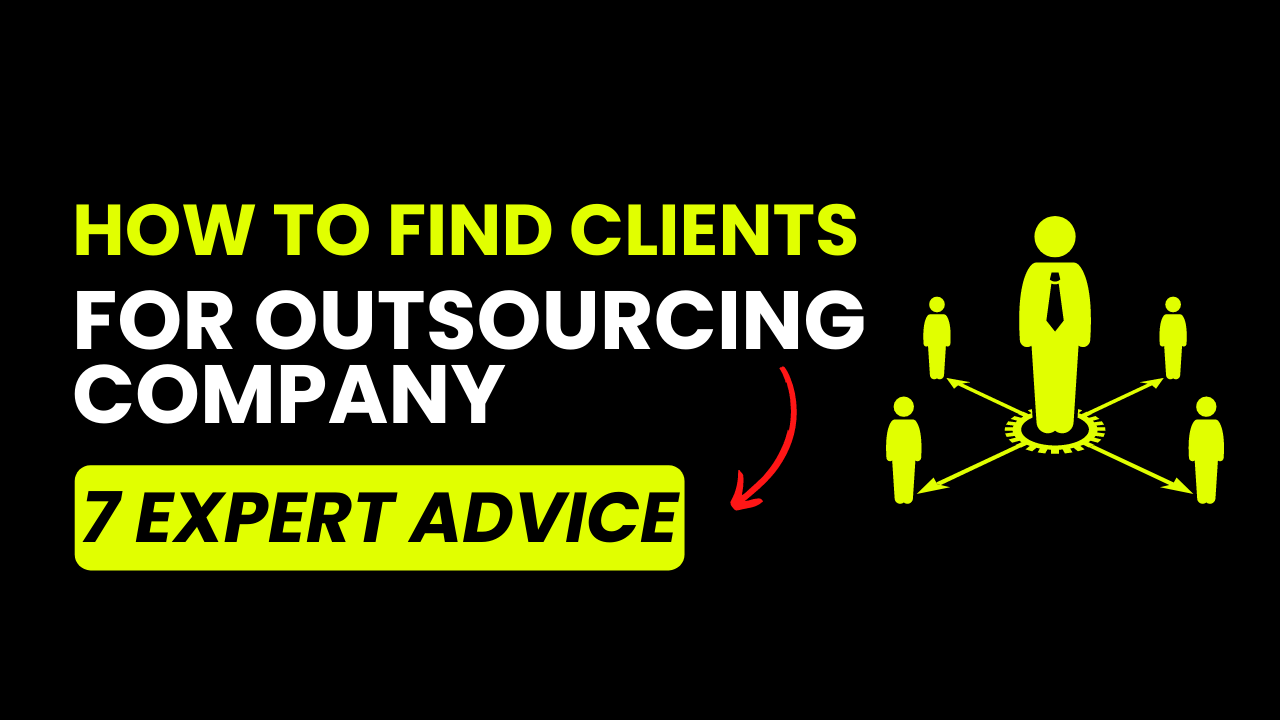You run an outsourcing business, and like any business, you need clients.
Simple, right?
Not exactly.
Finding the right clients is often the hardest part.
But here’s the good news: you’re in the right place.
We created this article to be your guide, your map, your compass – call it what you will but here you’ll find everything you need to get those precious clients for your outsourcing company in 2025.
Ready? Let’s get started.
What Type of Clients Need to Outsource their Work?

Source: ZeroIn
“What type of clients need to outsource their work?” is a question that brings us face-to-face with a bunch of different answers.
The truth is, a surprising variety of businesses, both small and large, can benefit immensely from outsourcing companies. They span across industries and borders, united by their shared need to streamline operations, cut costs, and focus on their core competencies.
Let’s break them one by one.
Firstly, we have startups and small companies.
They are typically running on lean teams and leaner budgets, so they’re always on the lookout for ways to save resources.
Outsourcing allows them to delegate their non-core tasks, enabling them to focus on the heart of their business.
Secondly, larger companies, weighed down by their size and complexity, often find refuge in outsourcing.
They can outsource things that are too cumbersome for in-house management or tasks that require specialized knowledge that they don’t possess internally.
Then there are the online companies, the e-commerce giants, digital marketing agencies, and everything in between.
These entities often operate in a global arena, and outsourcing can provide them with the round-the-clock service they need.
Moreover, professionals like lawyers, doctors, consultants, and even freelancers often need outsourcing help for their administrative tasks, giving them more time to focus on their customers.
So, from an early-stage startup to a Fortune 500 company, the types of clients who need to outsource their work are diverse. Identifying these prospective clients is the first key step in your journey to becoming a successful outsourcing company in 2024.
Preparation Stage for Getting Outsourcing Clients
Before you rush headfirst into the task of finding clients, it’s critical to invest some time and energy into the preparation phase.
This is where you establish a clear understanding of your business, your target audience, and your unique selling points.
This preparation phase, in essence, is about getting your ducks in a row.
It’s about making your outsourcing company shine in the competitive market and honing your strategies before making the first contact with prospective clients.
Think of it as the pre-game rituals before a big match.
Your mindset, your tools, your tactics – all need to be honed and fine-tuned to perfection.
This preparation will allow you to approach prospective clients not as a desperate seller, but as a confident outreach expert.
Start with Ideal Customer Profile
Defining your Ideal Customer Profile (ICP) is a crucial first step in your preparation phase.
Picture your ICP as a blueprint of the perfect client for your outsourcing services.
It provides a clear image of who your services are designed to serve best.
Consider questions like:
- What is their industry?
- Where are they located?
- What is their company size?
- What kind of work do they need to outsource?
- Which challenges do they face that you could solve?
The answers to these queries will sketch out the contours of your ICP.
But why does it matter?
By understanding your ICP, you can make your marketing and sales efforts more targeted and efficient, and in turn, more effective.
Here’s an example of an ICP:
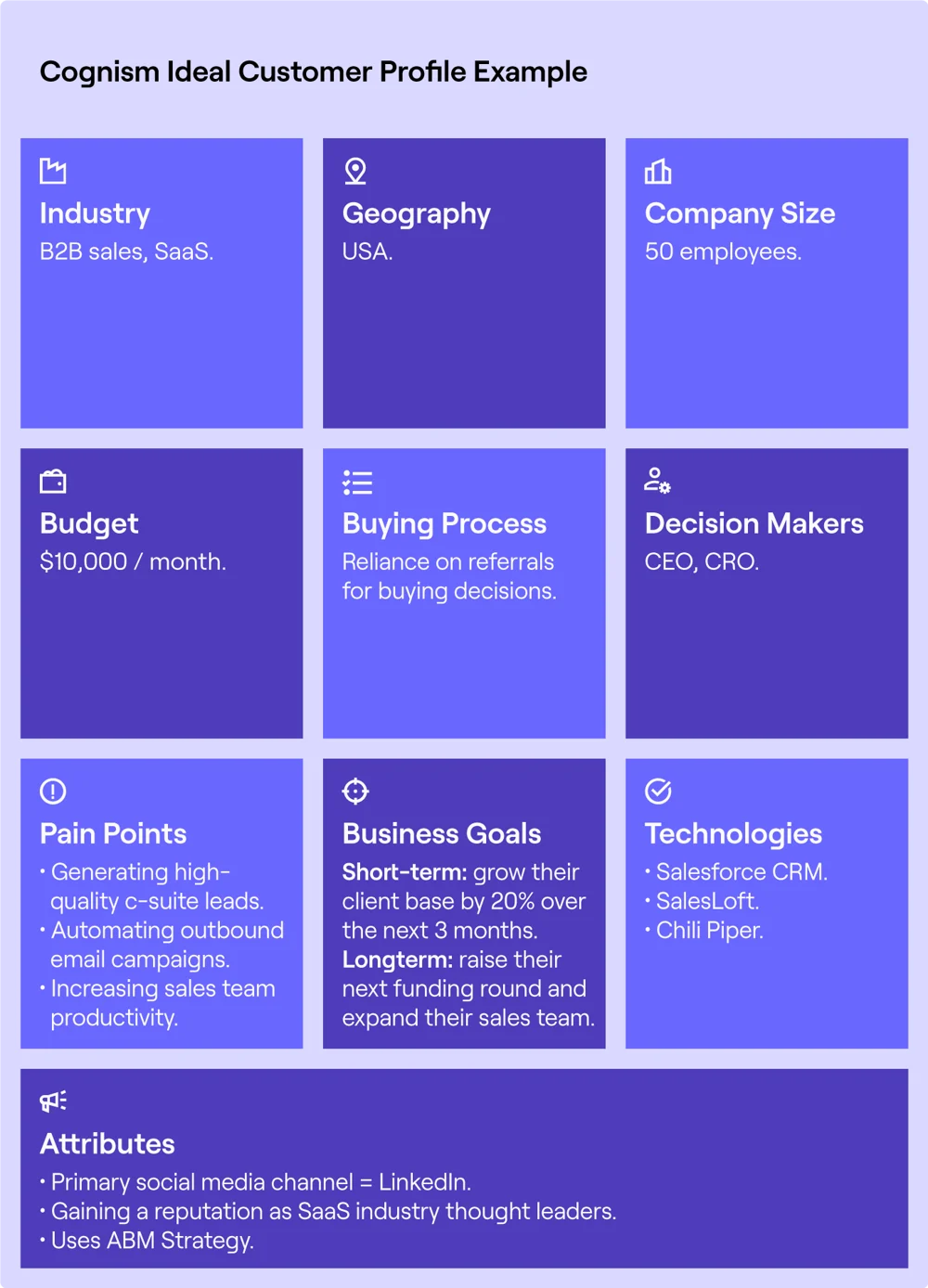
Source: Cognism
Develop your Unique Value Proposition
In a marketplace filled with countless competitors, your Unique Value Proposition (UVP) is your secret weapon.
It’s what differentiates you from the crowd, what makes you stand out, and ultimately, what makes clients choose you over others.
So, what’s your UVP?
Unique Value Proposition (UVP) is a succinct statement that clearly articulates the unique benefits your clients get from your outsourcing services, the key differentiators that separate you from your competitors, and the reasons why a client should choose you.

Source: Omniconvert
Sounds simple, right?
However, crafting an impactful UVP requires deep introspection into your business.
You need to understand your strengths, identify what you do best, and find out how these strengths align with your ICP’s needs.
It could be your affordable pricing, your exceptional customer service, your specialized knowledge in a particular industry, or your robust process and system.
Once you have your UVP defined, weave it into every aspect of your marketing and sales process.
Make it the heartbeat of your brand.
It should be the theme that resonates in your website copy, social media posts, marketing collateral, and sales pitches.
A powerful UVP not only attracts the right clients but also turns them into loyal advocates for your brand.
Here’s an example of a powerful UVP:
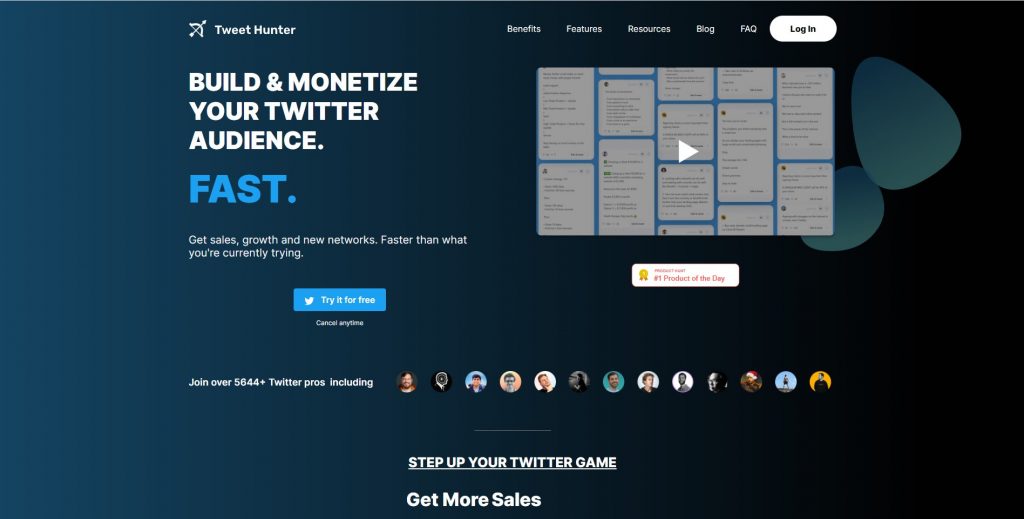
Improve your Portfolio
With your ICP and UVP established, it’s time to focus on your portfolio.
As an outsourcing company, your portfolio is the visual proof of your skills, expertise, and past successes.
It’s a showcase that builds trust with prospective clients and convinces them that you’re the right choice.
To polish/build your portfolio start by collating your best work.
This could include projects you’ve worked on, the challenges you’ve overcome, and the successes you’ve celebrated.
Each entry in your portfolio should highlight your abilities and reflect the quality of your service.
Don’t just list the projects; tell the story behind them.
The initial challenges, the strategies you employed, the results you delivered, the feedback you received – all these details make your portfolio more engaging and convincing.
In addition, it’s vital to ensure your portfolio is easily accessible.
Whether it’s on your site or a public platform, it should be easy for prospective clients to find and navigate through your portfolio.
Set up your Website
Building upon the strong foundation of your ICP, UVP, and polished portfolio, the next phase is to create an online space that embodies your business, and that is your website.
And no, your website isn’t just a digital address.
It’s your business’s online headquarters, a hub for prospective clients to learn about you and your offer, view your portfolio, and initiate contact.
Additionally, it is an integrated platform where you can regularly engage customers with insightful blog content, helping you build trust and establish thought leadership.
Envision your site as a dedicated, tireless salesperson who never clocks out. Accompanied by your blog, it’s a dynamic duo working in synergy.
Together, they should efficiently convey your UVP, highlight your best work, provide intriguing blog posts, and offer a seamless method for prospective buyers to initiate contact.
Now a few tips for your website:
1) Your site should embody professionalism in design, be intuitive to navigate, and ensure responsiveness across a wide range of devices whether it be mobile, tablet, or computer.
2) Each blog post should be crafted with care and created to be an engaging read while showcasing your expertise and thought leadership.
3) The aesthetic and content of your website, should mirror your brand and resonate with your ICP.
4) Also, do not overlook the importance of search engine optimization for both your website and your blog. Deploy appropriate keywords, optimize your images, and leverage good on-page Google SEO practices on every page and every blog post. The purpose of this is to aid your website and blog in appearing more frequently in search results when prospective clients are scouting for outsourcing companies or freelancers online.
Here’s what a great website looks like:
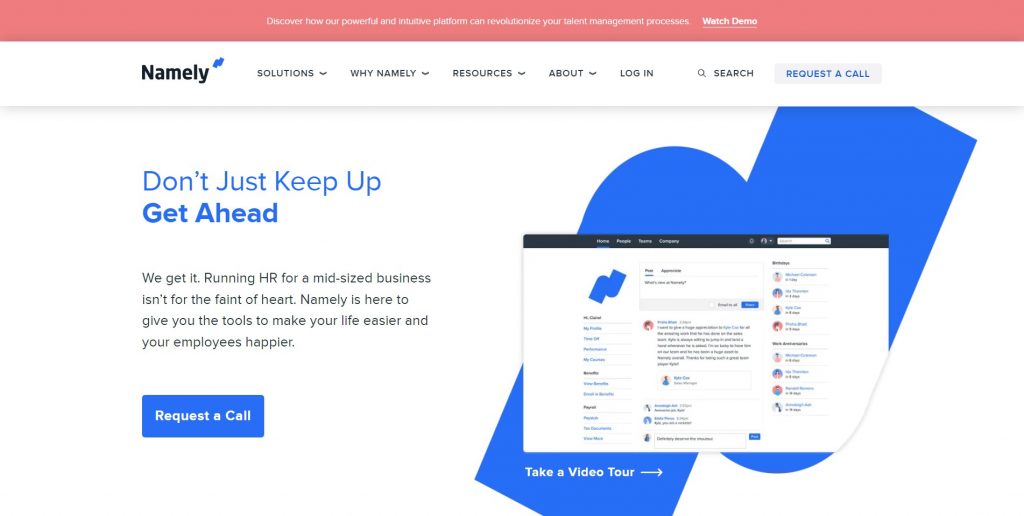
Source: Namely
Get Your Social Media Up and Running
In our hyper-connected digital world, setting up your social media profiles is a vital step in the preparation phase.
Social media platforms provide a unique opportunity to engage with your prospective customers on a more personal, interactive level, building awareness, and fostering relationships.
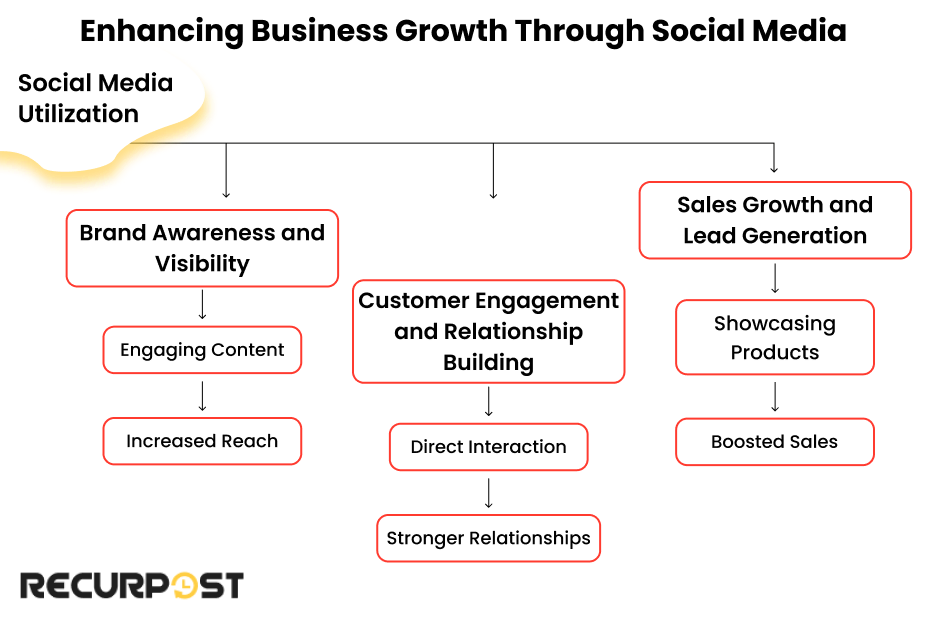
Source: Recurpost
Now, the first step in this journey is to identify the platforms your ideal customers frequent.
For B2B companies, LinkedIn is often a goldmine, but don’t overlook Facebook and X, there are plenty of potential clients there too.
Once you’ve identified the platforms, the next step is to build your presence.
Make sure your profiles are fully completed, reflecting your brand image, and communicate your UVP.
Each post, image, or video should add value to your audience, whether it’s an insight into your work process, a success story, or industry news.
But remember, social media isn’t a one-way street.
It’s about engaging with your audience – responding to comments, participating in discussions, and even starting conversations.
Social listening, or keeping tabs on industry trends, can also help you identify potential leads.
Your social media profiles are more than just broadcast channels; they are communities where you can build your brand’s personality and engage directly with prospective clients.
Set them upright, and they could be your gateway to an endless pool of prospects.
Implement Light CRM at the Outset
Once your site is up, your portfolio is polished, and your social media channels are buzzing, it’s time to consider a tool that can streamline your client acquisition process – a CRM or Customer Relationship Management system.
In the initial stages of your business, light CRM software will be more than enough.
This software can help you track leads, manage client interactions, and analyze customer data.
Think of it as your assistant that organizes and manages all your customer-related data in one place.
The beauty of a light CRM is that it can adapt to your needs as your business grows.
In the beginning, it could merely help you keep track of leads and client communications.
As your business expands, you can leverage its capabilities to manage email campaigns, automate follow-ups, generate reports, and much more.
Remember, the goal of using CRM software isn’t just to be organized, but to enhance your client relationships.
By having a well-structured view of your customer data, you can offer more personalized and timely services.
This can play a significant role in converting prospective leads into actual clients.
A light Customer Relationship Management software in the start can be a powerhouse that propels your client acquisition strategy forward.
If you are looking for a free light CRM tool, make sure to check out ZeroIn. Although its originally all-in-one email discovery solution, it has a complete CRM for effortless organization and management of valuable prospect data.
Assemble Pricing Policies and Packages
As you lay the groundwork for attracting customers to your outsourcing company, setting up clear pricing policies and packages is a crucial step.
Your pricing not only affects your revenue and profitability but also plays a key role in how prospective buyers perceive the value of your offers.
To assemble prices and packages, start by researching competitor companies and understanding the market rate for similar outsourcing services.
This will give you a ballpark figure to start with.
Next, consider your costs and desired profit margins.
Your pricing needs to cover your costs, ensure a healthy profit, and still present a value proposition to your clients.
Once you have a basic pricing structure, consider creating packaged offerings.
Rather than having a la carte services, packages bundle several ones together at a discounted rate.
Here’s an example of our pricing:
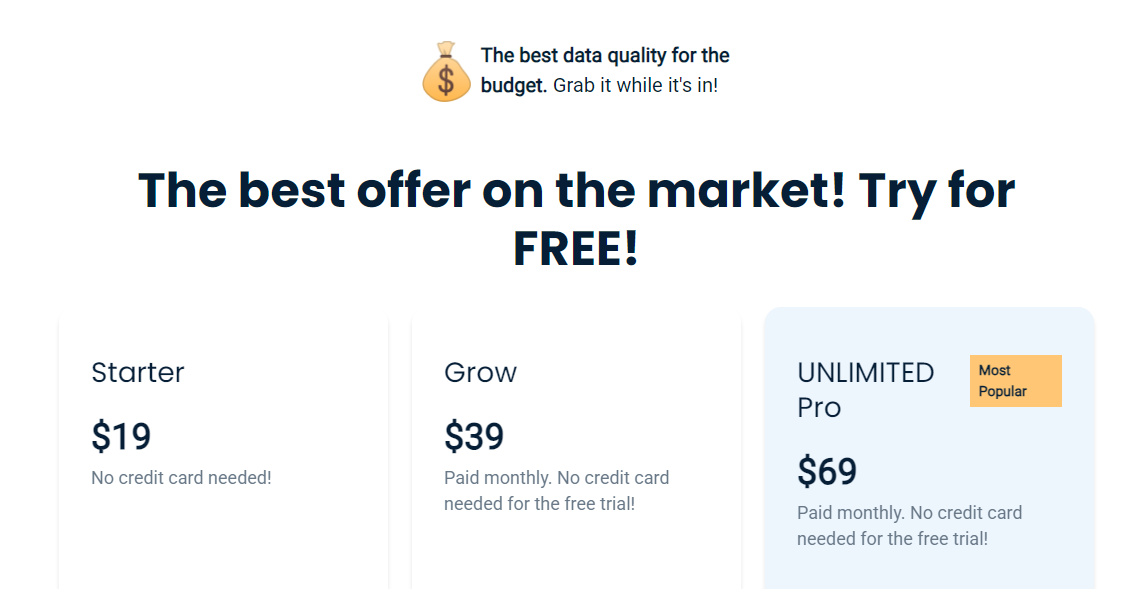
Source: ZeroIn
Although our offer isn’t a service, rather it’s a tool, you see where are we going with this.
This can be more appealing to prospective customers as it provides better value and simplifies their decision-making process.
By setting up clear pricing policies and packages, you reassure customers that they are making a wise investment when they choose you over other outsourcing companies.
Performing Stage – 7 Ways to Get More Clients for Outsourcing Business in 2025
With your groundwork firmly in place, you’re ready to step onto the stage – it’s showtime!
In this section, we’re going to explore 7 powerful ways to attract more customers for your outsourcing business.
From networking and event planning to organic LinkedIn strategies, these methods are tried, tested, and proven to deliver results.
Keep in mind – it’s not about using all these strategies at once. It’s about selecting the ones that align with your brand, your market, and your resources.
Ready to ramp up your client acquisition and massively boost revenue in 2025?
Let’s dive in!
1. Attend and Plan Events
Events, whether virtual or physical, are fertile grounds for connecting with prospective clients.
They offer unique opportunities to showcase your brand, interact with prospects, and establish yourself as a thought leader in your industry.
Consider hosting webinars or workshops related to outsourcing.

Source: ZeroIn
These events can position you as an expert, providing valuable information and demonstrating your knowledge and skills. It can be a great way to engage prospective buyers and move them closer to choosing you.
On the other hand, attending industry events, conferences, or trade shows can also be beneficial. These venues give you the chance to meet prospective clients, understand their needs, and present your business as a solution.

Source: ZeroIn
Whether you’re hosting or attending, remember to follow up on the connections you make during these events. A simple email or a phone call can help you stay top of mind and move the conversation forward.
Remember, events are more than just promotional platforms.
They are opportunities to build relationships and foster trust.
So, as you plan or attend events, focus on adding value and building connections.
These can be your stepping stones to acquiring more customers for your outsourcing company.
2. Take Advantage of Freelance Platforms
Freelance platforms are bustling digital marketplaces teeming with prospective clients.
Websites like Upwork, Fiverr, Freelancer, and others serve as bridges, connecting companies seeking services with professionals (mostly freelancers) providing them.
As an outsourcing company, these platforms can serve as invaluable tools to tap into a global client base.
Note: if you are not sure which one to choose, check this comparison.
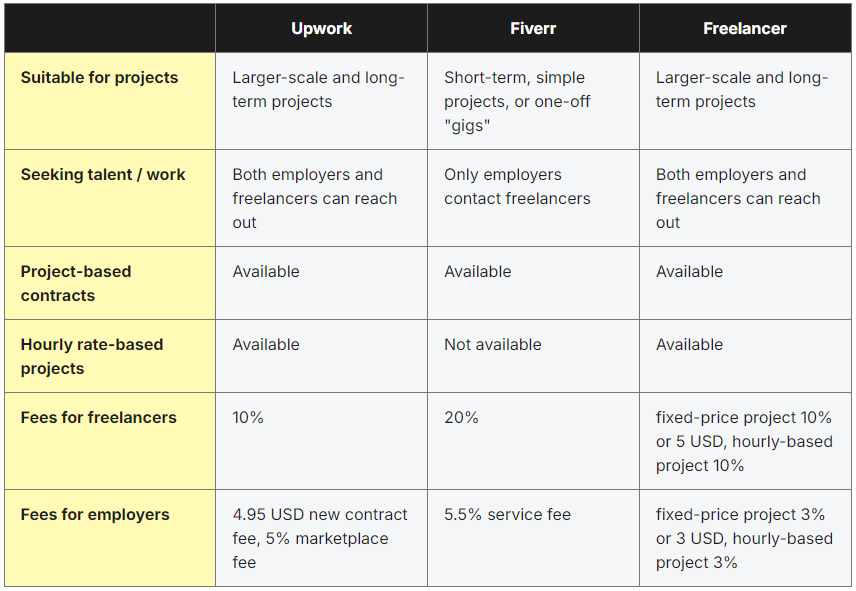
Source: Upsilon
Leveraging them is probably the easiest way to get clients for your outsourcing company.
First, create a compelling profile that highlights your offer, expertise, and past work.
Much like your website, your profile should communicate your UVP and showcase your work.
Keep in mind, prospective clients will judge you based on your profile so it needs to present you in the best light.
But the magic of freelance platforms isn’t just in showcasing your offers; it lies in actively searching for prospective clients.
Many companies post their requirements on these platforms, and you can submit proposals or bids for these projects.
However, winning bids can be challenging given the competitive nature of these platforms but it’s not hard to stand out. By crafting personalized, detailed proposals that show you’ve taken the time to understand the client’s needs and can provide the right solution, you can easily get noticed by prospecting clients.
It’s crucial to bear in mind though that while freelance platforms can be a great starting point, becoming overly dependent on them can be risky. Consider them only as one of many tools in your arsenal to find customers for your outsourcing company.
3. Reach Out to Decision Makers
The path to finding clients for your outsourcing company often involves getting your services in front of the decision-makers – the people who have the authority and the need to hire you.
Directly reaching out to these key individuals can yield fruitful results, especially if done right.
You might be thinking, “How do I find these decision-makers?“
The answer lies in smart prospecting.
Tools like LinkedIn can be useful in identifying the individuals within a company who might be interested in your offer. For a more streamlined and efficient approach, consider using a service like ZeroIn. This all-in-one email discovery platform simplifies the process of finding and organizing vital prospect data, enabling you to get in touch with the right people.
Here’s how ZeroIn looks like in action:
Once you have identified the decision-makers, it’s time to craft a compelling message.
Tailor your approach based on the person’s role, their company’s industry, and their specific needs.
The goal here is not just to promote your business but to demonstrate that you understand their challenges and can provide the right solution.
A well-planned, personalized outreach can open doors and conversations, leading to meaningful relationships and prospective client partnerships.
Always remember that behind every business decision is a person – reaching out to them can be your direct line to securing more clients.
4. Utilize Marketplaces/Agency Directories
Marketplaces and agency directories serve as giant, digital billboards where outsourcing companies like yours can showcase their services to a broad audience.
Websites like Clutch, Agency Spotter, or GoodFirms are renowned for offering a platform where B2B companies in need of outsourcing can easily find service providers. (You can find more of these just by doing a quick Google search)
Getting listed on these platforms is like setting up shop in a busy digital marketplace.
Your presence alone can catch the eye of a prospective client browsing the platform.
The key here is to ensure your listing is both informative and appealing, with a clear description of your offer, unique selling proposition, and customer testimonials.
Moreover, these platforms often have rating and review systems.
By delivering excellent services and encouraging your clients to leave positive reviews, you can boost your visibility and credibility on these platforms.
This can greatly increase your chances of being noticed and selected by prospective clients.
While listing your agency in these directories, don’t just passively wait for prospective buyers to stumble upon you.
Be proactive.
Explore opportunities, engage with businesses, and present your services as a potential solution to their needs.
Don’t underestimate the power of being in the right place at the right time.
By securing a spot in these marketplaces and agency directories, you’re positioning your outsourcing company for discovery and growth.
After all, visibility is the first step toward conversion.
Navigate these platforms wisely, and they could be your highway to an ever-expanding client base.
5. Combine Organic LinkedIn Efforts with Paid Strategies
LinkedIn, the world’s largest professional network in 2025, with more than a billion users, serves as an ideal platform to find, connect, and engage with prospective buyers in your industry.
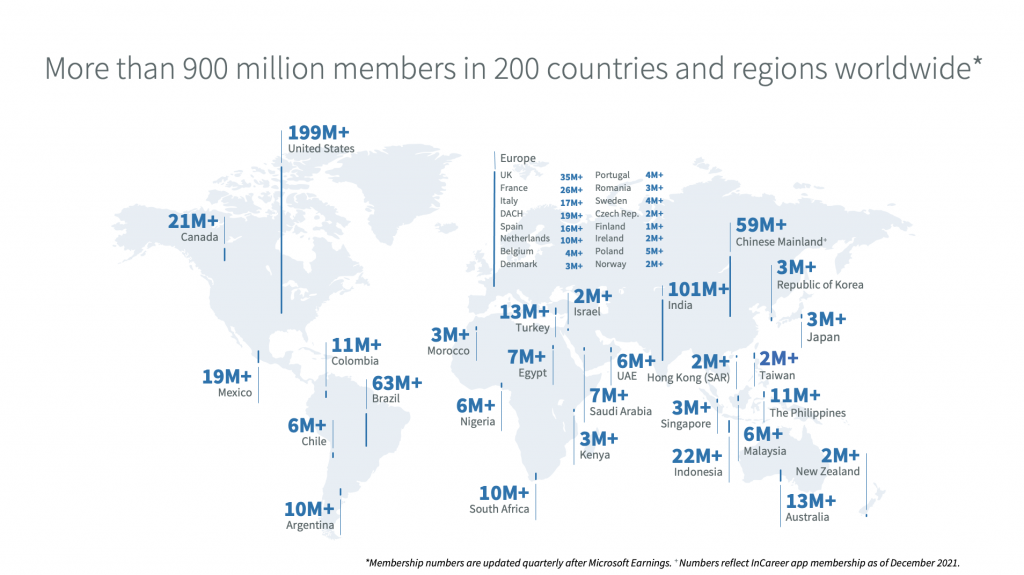
Source: LinkedIn
And it offers two distinct routes – organic and paid.
On the organic side, the focus is on cultivating relationships and establishing your company’s reputation.
Here you have a company’s LinkedIn page and your personal profile.
Both should clearly communicate who you are, what you do, and what sets you apart.
But that’s just the start.
Participation is key in the organic approach.
Engage in discussions, join groups related to your industry, and share value-driven content.
Posts that provide insight into your industry, share your company’s successes, or start a discussion can draw attention and demonstrate your expertise.
Remember, every comment, like, or share increases your visibility on the platform.
On the other side we have paid promotions on LinkedIn.
LinkedIn Ads can propel your message onto the screens of the exact audience you want to target.
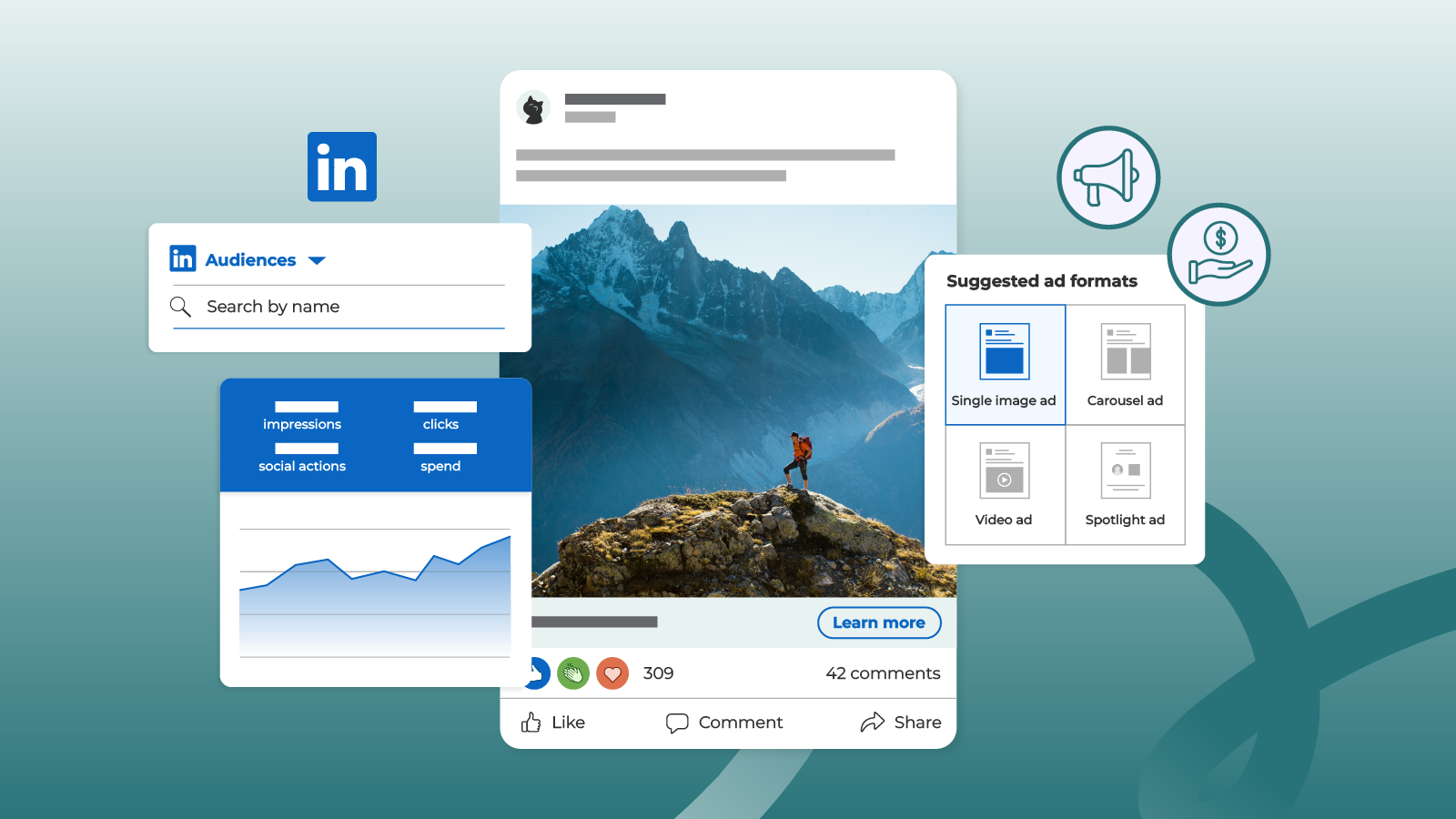
Source: Loomly
You can filter your audience based on job titles, industries, company sizes, and more, ensuring that your message reaches the right people.
And then there’s LinkedIn’s InMail service, a powerful tool for directly contacting prospective clients.
InMails allow you to bypass regular channels and deliver personalized messages straight to the inboxes of decision-makers.
It’s important to remember that LinkedIn is more than just a promotional platform; it’s a networking hub. So, while promoting your services, remember to engage, contribute, and provide value. It’s about building relationships as much as it’s about selling.
6. Be Helpful on Quora and Reddit
Imagine walking into a room filled with curious minds, all brimming with questions. Some are business owners looking for solutions, while others are professionals seeking advice. Welcome to the digital ecosystems of Quora and Reddit.
On these platforms, helpfulness and expertise are the currencies that buy attention and trust.
These sites are not meant for overt selling.
Instead, they give you the chance to showcase your knowledge, establish your brand’s authority, and subtly guide prospective buyers toward you.
Quora is an excellent platform to demonstrate your industry expertise and thought leadership.
The platform is full of users posing questions about every topic under the sun, including outsourcing.
Look for queries where your expertise can add value and provide in-depth, insightful answers.
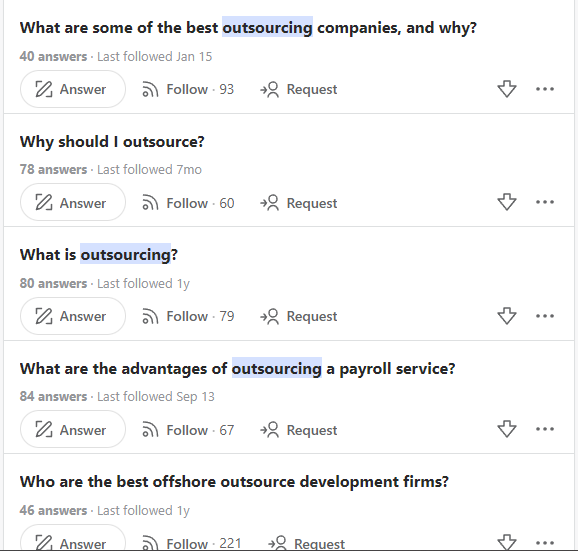
Source: Quora
Make sure your responses are not just informative but also engaging, as well-told stories tend to garner more views and upvotes.
On Reddit, you’ll find a multitude of ‘subreddits’ – smaller communities centered around specific topics.
Seek out subreddits related to business, entrepreneurship, or specific industries that could benefit from outsourcing.
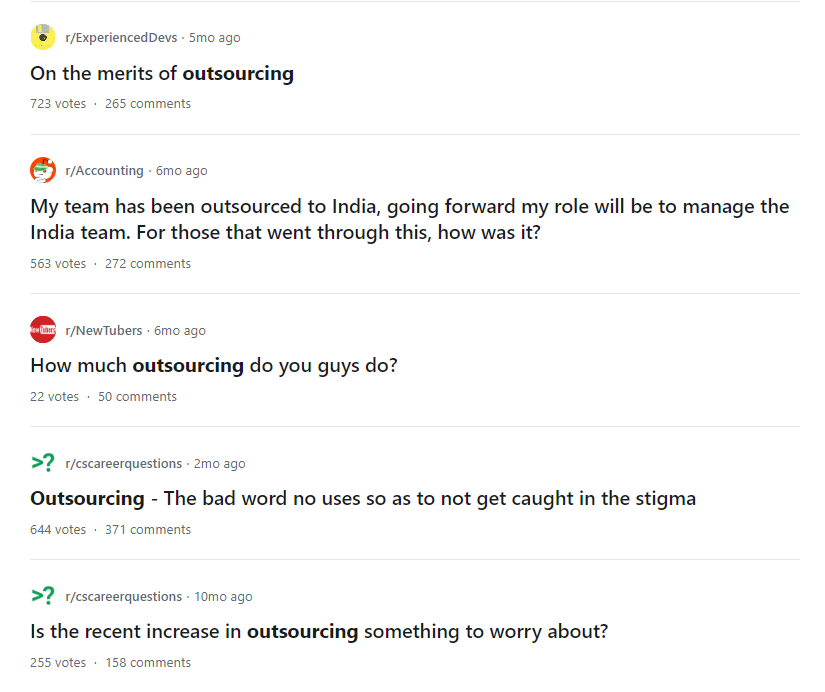
Source: Reddit
Like Quora, Reddit values genuine, informative content.
Engage in discussions, answer questions, and provide advice, always keeping your interactions authentic and helpful.
While it’s okay to mention your services where relevant, remember to avoid overt self-promotion, as this can be off-putting and even against community rules in some cases. Instead, focus on positioning your brand as a helpful expert, ready to provide solutions and share knowledge.
Consistent participation on Quora and Reddit won’t just increase your brand’s visibility – it’ll also help you build industry authority.
Over time, this credibility can naturally draw prospective customers towards your outsourcing company, opening doors to meaningful conversations and, eventually, fruitful partnerships.
7. Network
In the business of outsourcing, making connections is everything.
Everything is about meeting people, sharing experiences, and, most importantly, letting the world know you exist.
While every other strategy might focus on the ‘digital’ aspect, networking remains rooted in the age-old practice of forming and nurturing relationships.
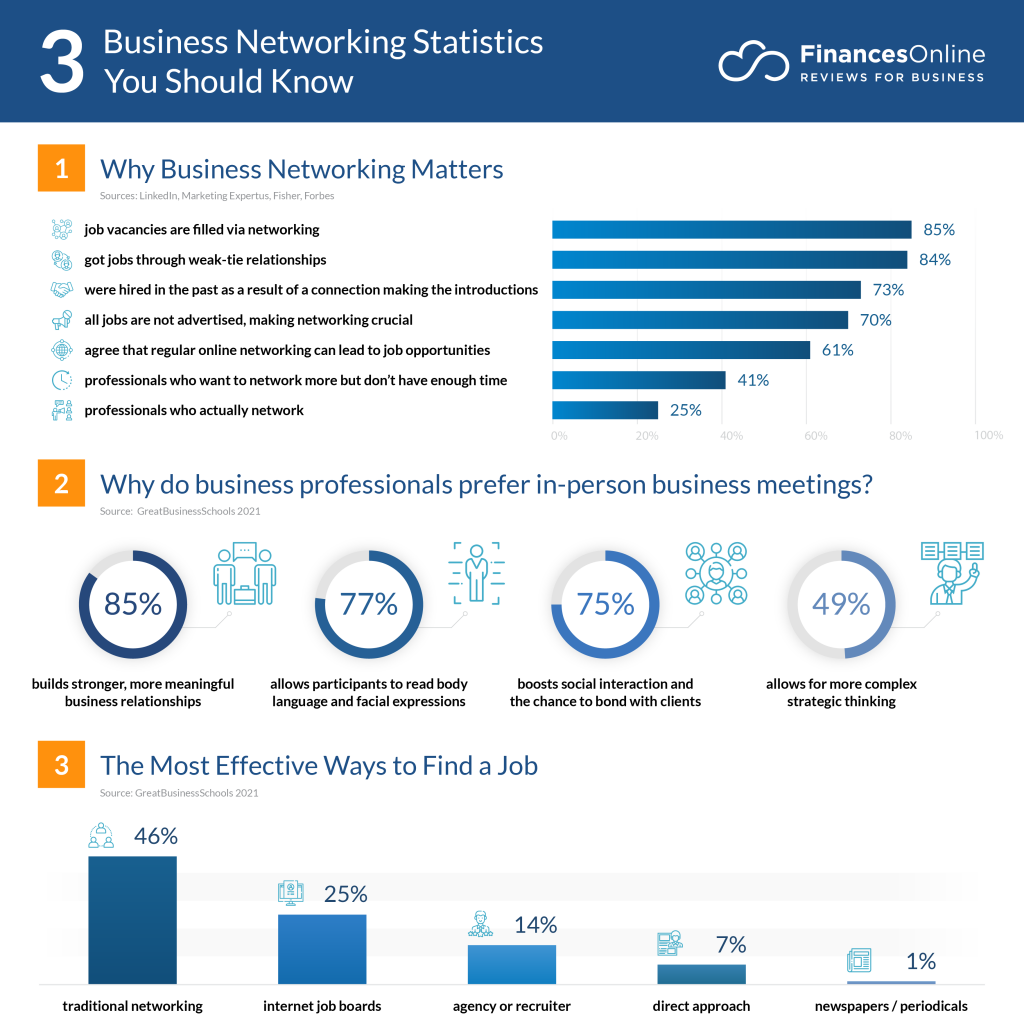
Source: FinancesOnline
Start by joining local and international industry events, forums, and associations.
These gatherings are fertile ground for making connections and learning about the latest trends and challenges in your industry.
Attend these events with a genuine interest in others, and opportunities will come knocking.
Furthermore, leverage digital networking platforms like LinkedIn, Twitter, or industry-specific forums.
Follow thought leaders, join discussions, and contribute your insights.
The more active you are, the more noticeable you become.
But remember, networking is not just about taking – it’s about giving as well.
Offer your help, share your resources, and contribute to your community.
The goodwill you cultivate now can reap immense rewards down the line.
Extra tip: Send Personalized Proposals!
Here’s a bonus nugget of wisdom for you – the power of personalized proposals.
It’s simple, yet so many B2B companies fail to capitalize on it, preferring to take the easy route of generic, mass-produced proposals.
Imagine you’re a prospective client, and you receive two proposals.
The first one is generic, a cookie-cutter proposal that could be sent to anyone.
‘Hi Alex,
I came across your company, BrightWave Solutions, and thought I’d reach out. We offer a range of outsourcing services, like customer support, virtual assistance, and admin tasks. Let me know if you’re interested, and we can discuss pricing.
Looking forward to your response.’
The second one, though, is clearly crafted with you in mind:
‘Hi Alex,
I’ve been following BrightWave Solutions and was impressed by your recent expansion into SaaS development. Scaling a team while maintaining quality is no small feat, and your success is a testament to your leadership.
That said, I noticed your team is hiring for multiple customer-facing roles, which can be both time-intensive and costly to manage internally. My team at EfficientPro Outsourcing specializes in streamlining customer support and administrative workflows, allowing companies like yours to focus on growth without sacrificing quality.
Here’s what we’ve done for companies in your space:
- Helped NexusTech reduce customer support costs by 40% while maintaining a 98% customer satisfaction rate.
- Enabled NovaCorp to scale operations without increasing overhead by outsourcing administrative workflows, saving them over $50,000 annually.
I’ve attached a proposal tailored to BrightWave Solutions. It outlines specific ways outsourcing can help you scale your operations, reduce costs, and free up internal resources for strategic initiatives.
Would you be open to a quick 20-minute call this week? I’d love to discuss how outsourcing can help BrightWave focus on what you do best while we handle the rest.
Looking forward to hearing your thoughts!
Best regards,
John Smith’
It addresses your specific needs, outlines how the services offered can solve your unique problems, and even includes a few details that show they’ve done their homework about your company.
Which one would you choose?
The answer is clear.
In the ocean of competition, personalized proposals can be your lifeboat.
They show prospective buyers that you care, that you’ve taken the time to understand their needs, and that you’re genuinely interested in helping them.
In a world where automation is the norm, personal touches can be a game-changer.
Use the information you gathered during your prospecting phase to craft proposals that speak directly to your prospective client’s needs.
Mention their company name, reference their projects or any challenges they may be facing, and explain how your services can help them overcome those challenges.
And remember, while sending out personalized proposals might be more time-consuming, they can dramatically increase your conversion rates, making it a worthy investment.
So, take the time, do the research, and make each proposal count.
Extra Extra Tip to Get Clients for Outsourcing Company: Implement Lead Scoring
As your outreach efforts start to gain momentum and leads come pouring in, it’s important to prioritize your attention effectively.
Not every lead that shows interest in your services is ready to buy.
Some might just be exploring their options, while others are ready to make a decision.
This is where lead scoring comes into play.
Lead scoring is a systematic way to rank your leads based on their level of interest and their fit with your services.
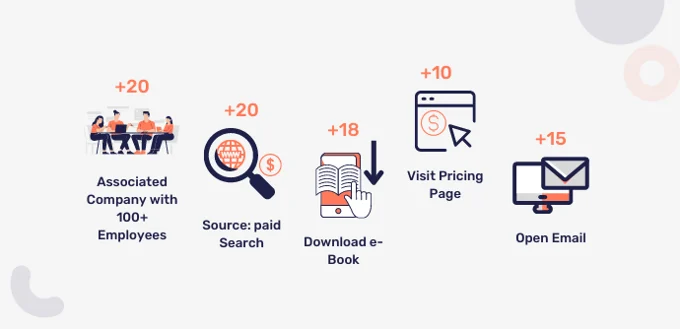
Source: 3&Four
Factors such as their engagement with your content, their position in the buying cycle, and their budget all come into play when scoring leads.
Perhaps someone visited your site multiple times, downloaded a case study, and has a role that would make them a decision-maker at a prospective client company.
This lead would score high and should be prioritized.
On the other hand, if a lead is from a company outside your target market and has only engaged with your content once or twice, their score would be lower.
By scoring your leads, you can focus your time and energy on the most promising prospects, improving efficiency and increasing the chances of conversion.
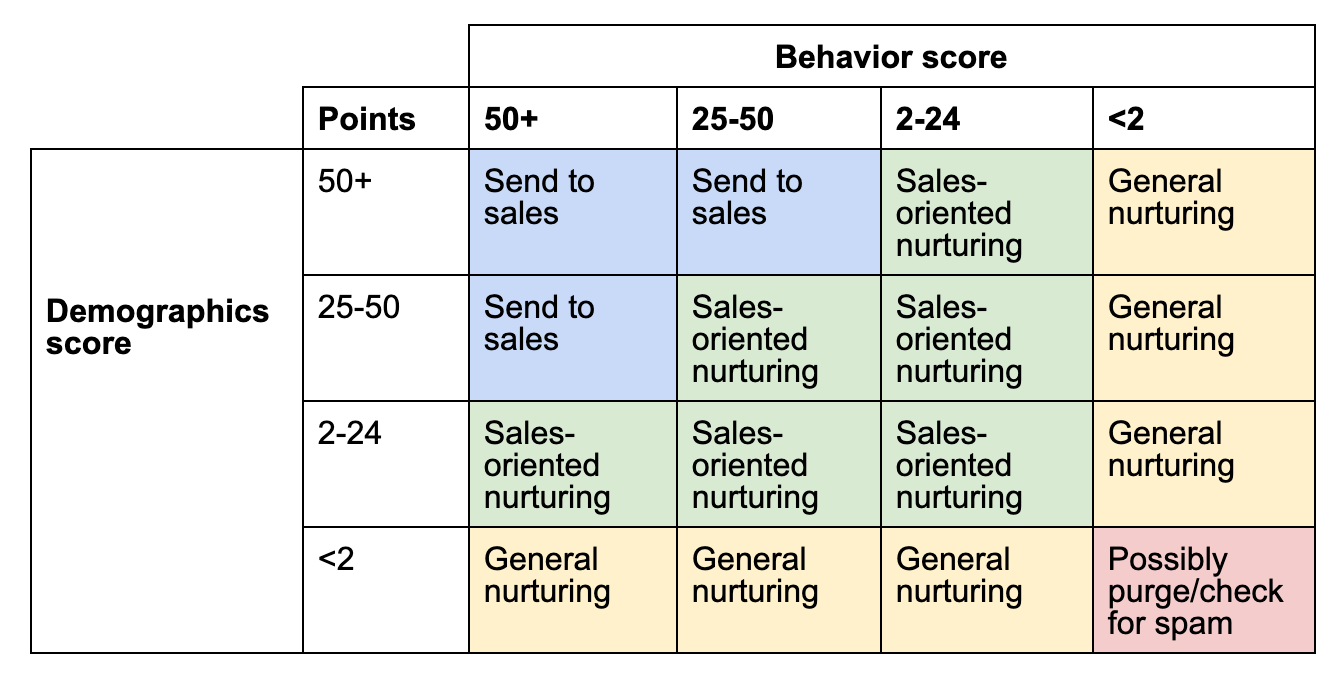
Source: GTMnow
Lead scoring might sound like an advanced tactic, but it’s a key process in ensuring that your efforts are invested in the right places.
And remember, the primary goal of lead scoring isn’t just about prioritizing your leads but understanding them better. It’s about recognizing where they are in their decision-making process and how your services align with their needs.
Measure Success and Test New Theories
As in any endeavor, progress and success in client acquisition are not left to guesswork.
You need a reliable way to measure your success and identify areas of improvement.
For this, you’ll need to track specific metrics and KPIs.
Some of them are:
– the number of new leads generated
– conversion rates
– cost per acquisition
– and the lifetime value of each client.
And here’s a list of 8 most important ones:
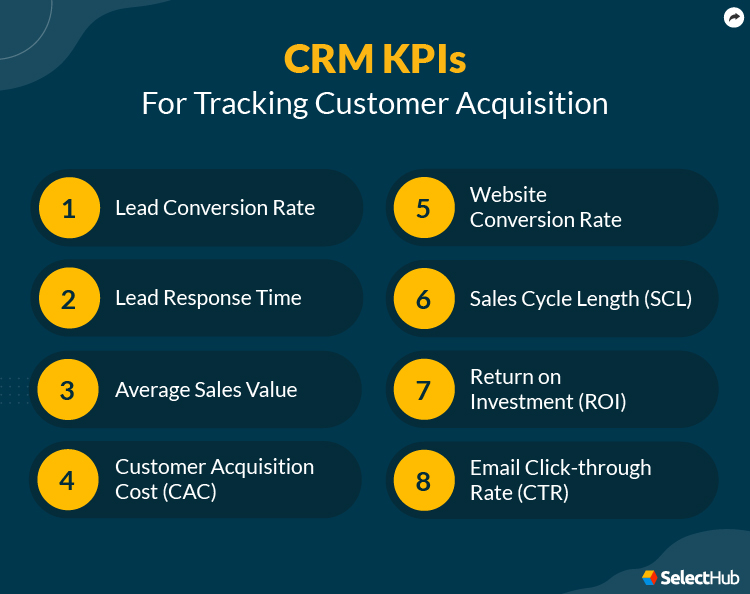
Source: SelectHub
Keeping a keen eye on these numbers will help you understand how effective your strategies are and where adjustments might be needed.
But don’t just stop at measuring.
The business landscape is dynamic, and so should your strategies.
Don’t shy away from testing new theories and ideas.
Maybe it’s a different approach to your social media content, a new angle in your proposals, or a completely new outreach channel.
Be open to experimentation and learn from the results.
Remember, it’s okay if new ideas don’t always work out.
Each ‘failure’ is an opportunity to learn, improve, and get one step closer to a strategy that hits the bullseye.
Find High-Quality Prospects and Close Deals Faster with ZeroIn!
In the world of client acquisition for your outsourcing company, the importance of finding high-quality prospects cannot be overstated. And that’s where ZeroIn steps in to revolutionize your prospecting process.
ZeroIn is an email discovery platform designed to simplify and streamline your prospecting journey.
It integrates seamlessly with LinkedIn Free or Sales Navigator searches, presenting a comprehensive view of your prospective clients based on your search criteria.
But ZeroIn offers more than just essential contact details.
It provides over 20 additional insights about your contacts and their organizations, helping you understand your prospects better and tailor your pitches more effectively.
With up to 26 distinctive data points, including verified business emails, and a 10-step verification process, ZeroIn ensures that you’re reaching out to the right people at the right addresses.
Whether you’re looking to import, re-verify, or export leads, ZeroIn is a one-stop solution for all your outreach efforts.
With ZeroIn at your fingertips, your journey to getting more clients for your outsourcing company is about to get faster, smoother, and more successful.
So why wait?
Find high-quality prospects and close deals faster with ZeroIn!
Companies that use ZeroIn:

Create a Free Account and Get 25 credits!
